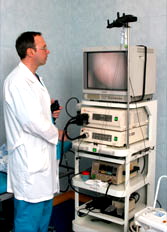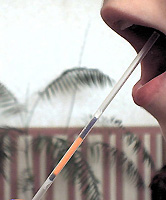What methods are used to diagnose gastroduodenitis? What is a respiratory test for Helicobaccant infection? Read in this article.
Content
Diagnosis of chronic duodenitis
To diagnose chronic duodenitis Currently, an endoscopy is used with which you can define visible and characteristic changes in the duodenum damage. Endoscopy is a method of studying internal organs using special endoscope devices (flexible plastic or metal tubes with lighting and optical system).
 Stomach pain and dyspeptic disorders (heartburn, nausea, belching, vomiting), similar to the diseases of the duodenum, may be caused by squeezing from the outside of the duodenum. To clarify than and how the duodenum is affected is used by duodenoscopy - the method of studying the duodenal mucosa of the duodenum by examining using a special device — Gastroduodenoscope, as well as a biopsy - studying the structure of a piece of tissue of the duodenum (this allows you to determine the form, the stage of the disease).
Stomach pain and dyspeptic disorders (heartburn, nausea, belching, vomiting), similar to the diseases of the duodenum, may be caused by squeezing from the outside of the duodenum. To clarify than and how the duodenum is affected is used by duodenoscopy - the method of studying the duodenal mucosa of the duodenum by examining using a special device — Gastroduodenoscope, as well as a biopsy - studying the structure of a piece of tissue of the duodenum (this allows you to determine the form, the stage of the disease).
When the disease is associated with the pathology of the pancreas, the system of biliary tract, liver, help such diagnostic procedures as an ultrasound (study of the state of organs and tissues using ultrasound waves), ERPHG (this is an x-ray endoscopic study of the pancreatobiliary organs: duodenum, duodenal nipples, bile Ducts, pancreatic ducts), MRPHG (magnetic resonance pancreatocholangiography allowing you to see bile ducts and pancreatic ducts in a three-dimensional image without the use of contrast), CT (research method based on obtaining images of tissues and organs with electromagnetic waves), MRI (research method Internal human internal organs using the physical phenomenon of nuclear magnetic resonance) and other modern diagnostic methods, which, due to relevant indications, can give accurate information about the nature of the defeat of the specified authorities.
X-ray examination in chronic duodenitis
X-ray study makes it possible to diagnose the deformation of the organ, including Rubtsovaya. In addition, with an x-ray-sensitive study it is possible to estimate its characteristics, the state of the stomach. X-ray study of the gastroduodenal zone allows you to identify the presence and duodenogastral reflux. Duodenogastral Reflux - This is the casting duodenal gut (bile) in stomach.
X-ray examination helps to reveal the sections in the duodenalist, in which the process of rebirthing fabric and sections with increased growth of the glands are underway, where tumors may later be formed.
Helicobachambater infection respiratory test
Since the main cause of the caller is the Helicobacter Pylori (Helicobacter Pylori), it is necessary to use the breathing test.
 Often, a study of the sample of tissues taken from the duodenum (biopsy) and a urease test is used for diagnostics. Urease test is determining the level of gastric ureaznaya activity. It is based on a specific mechanism for the biocobacter bacterium - the urea splitting contained in the contents of the stomach, the Uretoma enzyme. Ammonia and carbon dioxide formed as a result of the reaction. Acid-alkaline balance of the stomach (pH of the medium) shifts into the alkaline side, which is fixed using the indicator.
Often, a study of the sample of tissues taken from the duodenum (biopsy) and a urease test is used for diagnostics. Urease test is determining the level of gastric ureaznaya activity. It is based on a specific mechanism for the biocobacter bacterium - the urea splitting contained in the contents of the stomach, the Uretoma enzyme. Ammonia and carbon dioxide formed as a result of the reaction. Acid-alkaline balance of the stomach (pH of the medium) shifts into the alkaline side, which is fixed using the indicator.
A certain value for estimating the functional state of the stomach and duodenum in duodenitis is attached to methods of study of gastric acid formation. Monitoring (observation during the day) Acid formation of the stomach gives greater information about the amount, duration, crushing severity in the nearest duodenum sector, adequacy of obscure.
The method of duodenal sensing is when using a rubber tube introduced into the stomach, you can explore the properties of the duodenum secrets, the state of digestion, and also detect parasites in the duodenum and biliary tract (more informative than coprological).
The digestion quality is investigated using a coprological study. The function of the bereal system is determined by means of duodenal sensing, or the ultrasound method.









